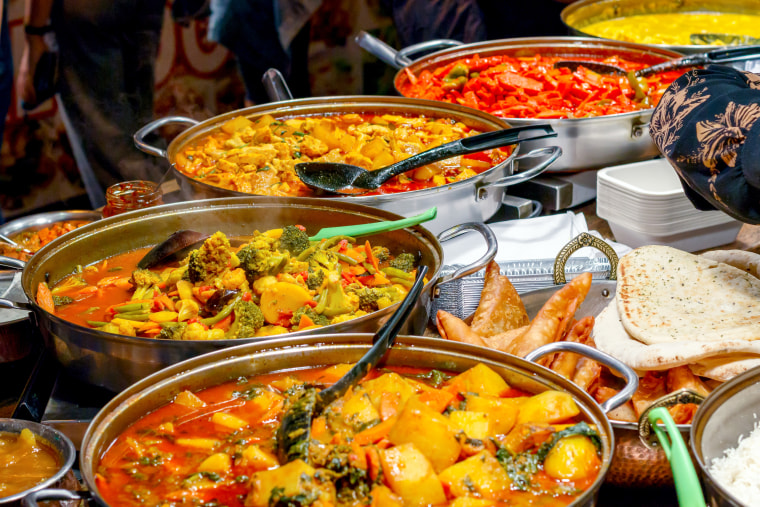Curry muncher. The phrase — or, more accurately, the racist slur — is not likely familiar to most Americans. As an Indian child who grew up partly in Australia and the neighboring country of Papua New Guinea in the 1980s, however, it was a slur I grew accustomed to hearing regularly on playgrounds and at school.
As an Indian child who grew up partly in Australia and the neighboring country of Papua New Guinea in the 1980s, however, it was a slur I grew accustomed to hearing.
The term made me feel racial and culinary shame — as it was designed to do. Not unlike other racist monikers that are anchored in culinary terms (think “kraut” for Germans or “beaner” for Mexicans) the knee-jerk racism of “curry muncher” is a reductive, derogatory way to refer to anyone brown who had origins in India, Pakistan, Bangladesh, Sri Lanka and other parts of the subcontinent.
It worked. At a very young age, I developed a visceral dislike for the term "curry" and would try to distance myself from it. I didn’t want to be called a curry muncher. I didn’t want to smell like curry. And I didn’t want to eat it.
But as a somewhat precocious child, I also knew the term "curry" was vague and amorphous. In fact, none of the so-called curries I would bring to school were actually referred to by the South Asian people I knew as such. There was masala, korma, dal, sambar: dishes that were made with a variety of spices (but never curry powder — that was always for white people) and cooked carefully with vegetables, lentils and pulses, or meat.
Though it would take many years for me to delve into the intricacies of the term and its colonial origins, I knew, even at the age of 7, that curry was not one thing. Curry, rather, is a convenient (and certainly inaccurate) portmanteau to describe a vast array of dishes that are eaten by the more than 1 billion people in South Asia, to say nothing of the various kinds of dishes called curry eaten in Thailand, Japan, Malaysia and beyond.
No amount of explanation, however, made much of a difference to my classmates. I would try to engage with my schoolyard critics and tell them that curry broadly speaking was not an ingredient that came in powdered form. It could not be distilled to a single yellow concoction sold in a jar. All manner of spices from peppercorns, cinnamon, anise, cayenne, cumin to coriander are delicately combined to create sophisticated flavor profiles that vary depending on the region or subcontinent you live in.
Sadly, while this level of ignorance may be excusable for elementary bullies, those of us who have been derided for our foods know such ignorance continues among self-proclaimed food experts. Gene Weingarten, a Washington Post columnist, learned very quickly that making summarily dismissive comments about Indian food’s “single ingredient” will garner pushback in today’s society. That’s a good thing. That Weingarten was able to so easily make, write and publish such an ignorant statement is less positive.
It remains incredibly frustrating to watch the (distant) descendants of the Europeans who colonized our countries for spices have the audacity (or caudacity) to not be able to distinguish among them.
Honestly, people of color are tired of this kind of white nonsense. It seems like every few weeks we hear a story about someone capitalizing on or denigrating Asian foods. As a scholar of food who researches the history and cultural practices of why people eat what they eat, it is exhausting to constantly come up against the kind of hubris that leads the Weingartens of the word to dismiss the culinary practices and preferences of communities, while promoting their own supposed authority.
It seems like every few weeks we hear a story about someone capitalizing on or denigrating Asian foods.
So, here’s an idea. Perhaps, we collectively agree that food cultures are interesting because they are complex. This is not about personal food preferences. There is a way to talk about food that doesn’t exoticize it or, equally bad, reduce a complex, hugely varied cuisine to a reductive, incorrect stereotype. Terms like "curry" are fraught because they carry the weight of colonial history, and that history informs what the average white person thinks when they hear the term “Indian food.” Curry became a quick way for the British to describe so much of the food of India with little respect for regional difference or nuance. So when people dismiss Indian food as “insane” or “weird,” it is not without historical precedent.
Because, again, “curry” is not a term that most Indians use to describe our food; it is an invention of white people. If we call our foods “curry,” it is to make things easier for the mainstream. I may not remember the names and faces of the white bullies who tormented me as a child anymore, but I do remember the sting of their words. Perhaps that is why when I hear about curry and Indian food being spoken about in such ignorant terms, I feel rage.
Ignorance is not harmless. I am not so naïve as to think we all need to like all food. But I do hope that when we do talk about foods with long and complex histories, we do so in a manner that recognizes our words, no matter how thoughtless, have consequences — whether on a playground or in the pages of The Washington Post.


